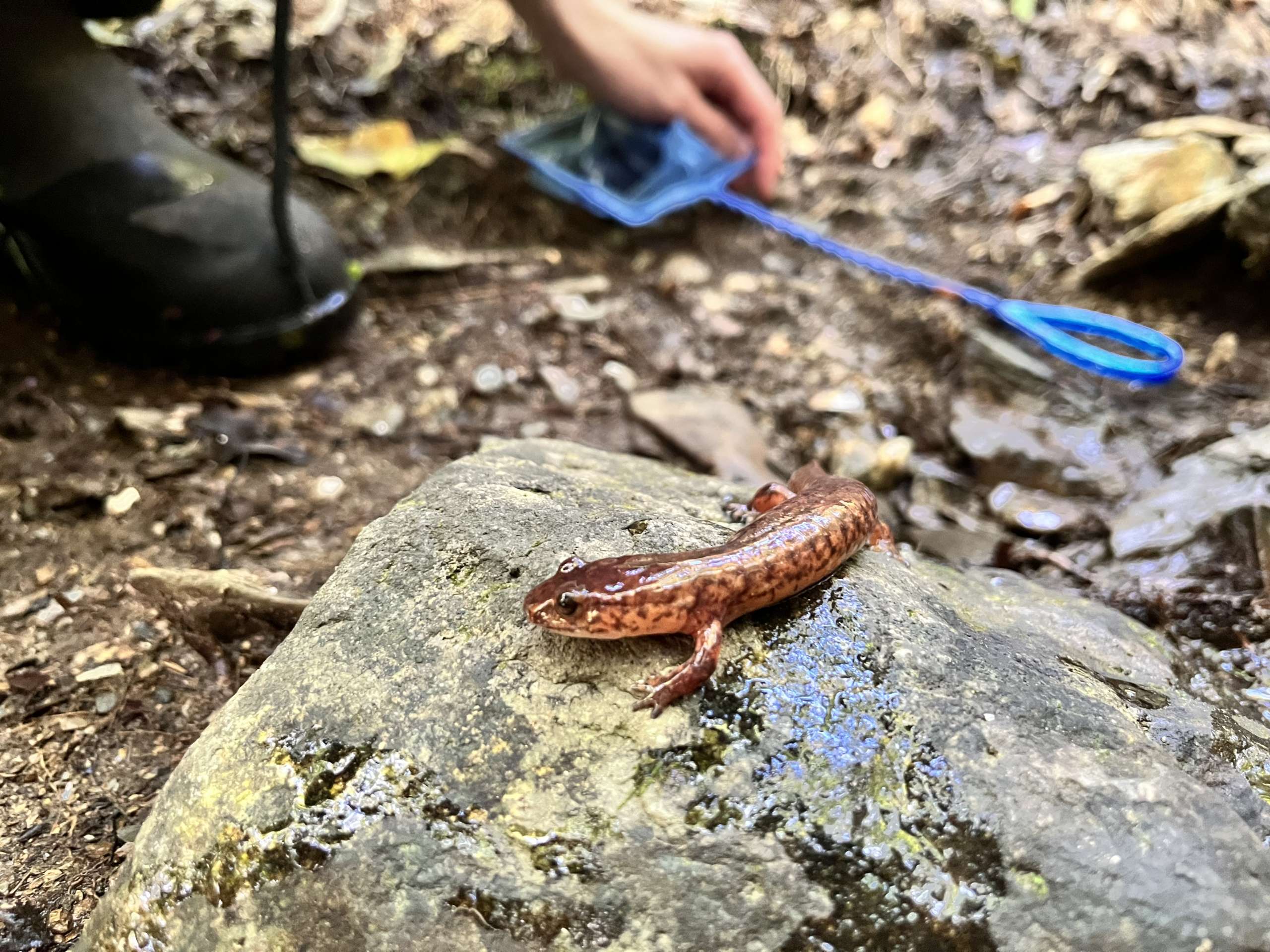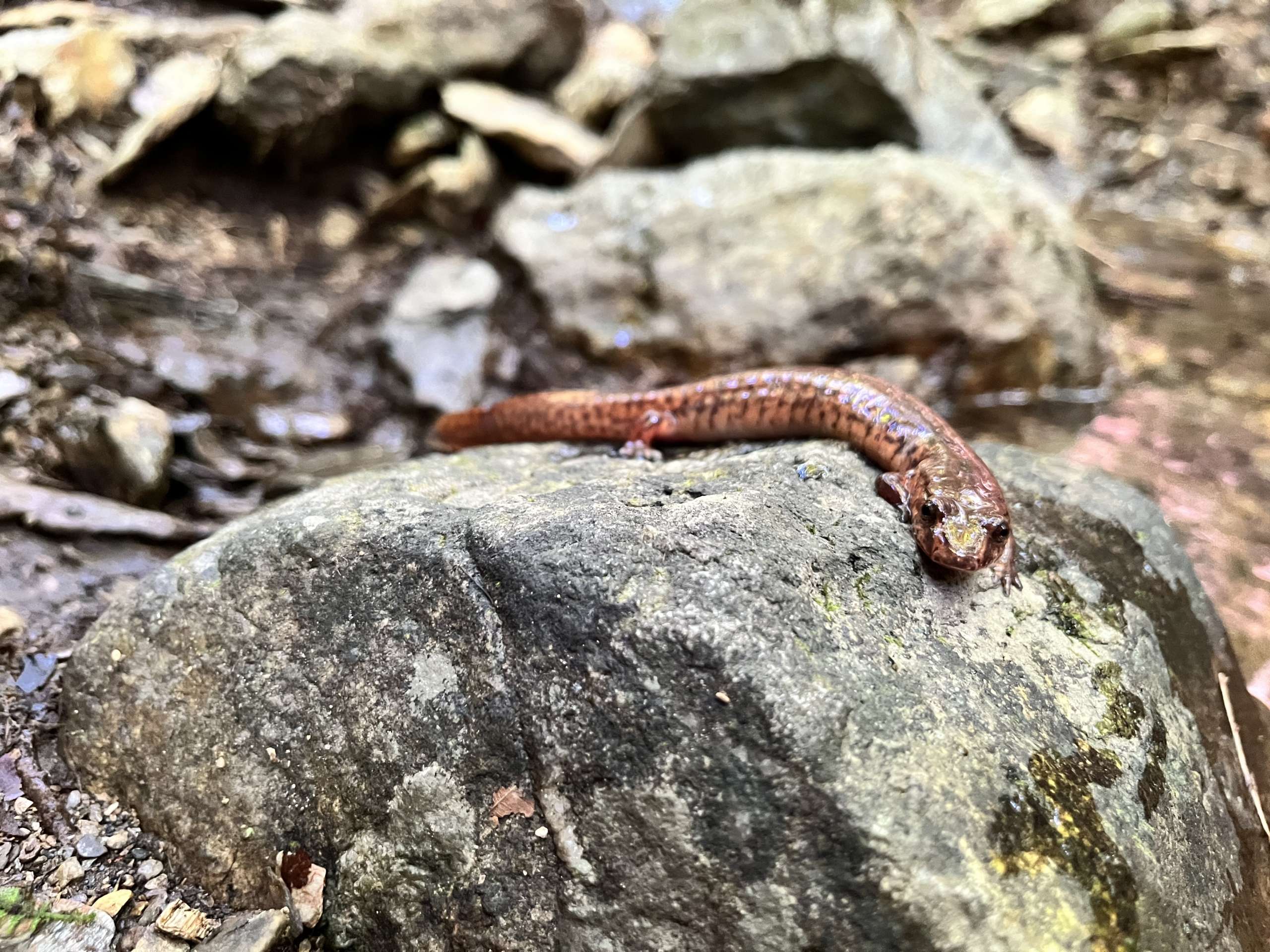Written by Nicolas Bousquet, Biol.
Field Project Coordinator
COGESAF

Reading time: 5-6 minutes

The Lake Massawippi watershed is home to several species of salamander, particularly the stream salamander. There are three species of stream salamander: the two-lined salamander, the northern dusky salamander and the purple salamander. The presence of numerous streams in forested and mountainous areas favours the presence of these species around Lake Massawippi.
Stream salamanders are very discreet but fascinating little creatures! These amphibians live mainly in small, cool, well-oxygenated streams. Surprisingly, this group of salamanders has no lungs, and breathes through its skin and larvae using gills. For this reason, stream salamanders must constantly keep their skin moist and live mainly in the aquatic environment. Although adults may venture a few meters from the stream into the terrestrial environment, they are usually found buried deep in the stream under rocks or other shelter such as branches. As for the larvae (juvenile salamanders), they are totally dependent on the aquatic environment, due to their gills.
deneme bonusu veren siteler
Because of their dependence on the aquatic environment, stream salamanders are very fragile species. In fact, the Northern Dusky Salamander is likely to be designated as threatened or vulnerable, and the Purple Salamander is designated as vulnerable under Quebec’s Act respecting threatened and vulnerable species. There are many conservation issues for stream salamanders, and generally speaking, they can be greatly affected by changes in the quantity and quality of the water in their habitat. Changes in the flow of a watercourse, deforestation of the riparian strip, sedimentation, contaminant inputs and the draining or drying up of watercourses are all factors that can considerably harm stream salamanders.
 It’s interesting to note that some of the Massawippi Conservation Trust properties have been included in an extensive long-term monitoring program for stream salamanders. There are currently two studies underway. Indeed, as these properties are free of anthropogenic threats, it is interesting to see the evolution of populations in this sector over a 10-year period. This data can then be compared with sites undergoing significant pressure, such as those under forest management. In addition, the project aims to understand the potential impact of climate change on stream salamander populations. It is possible that climate change will have an impact on stream salamanders, particularly with increasingly frequent and intense dry spells in summer.
It’s interesting to note that some of the Massawippi Conservation Trust properties have been included in an extensive long-term monitoring program for stream salamanders. There are currently two studies underway. Indeed, as these properties are free of anthropogenic threats, it is interesting to see the evolution of populations in this sector over a 10-year period. This data can then be compared with sites undergoing significant pressure, such as those under forest management. In addition, the project aims to understand the potential impact of climate change on stream salamander populations. It is possible that climate change will have an impact on stream salamanders, particularly with increasingly frequent and intense dry spells in summer.
 This long-term monitoring project stems from a problem often observed in the acquisition of rigorous data for population monitoring, particularly for species with precarious status. Indeed, the lack of funding for knowledge acquisition often results in significant gaps in our knowledge of population trends. The project sponsor, the Nature Conservancy of Canada, has therefore set up a long-term (10-year) monitoring program for the purple salamander throughout the Estrie region. Some ten conservation organizations are involved in the project, including COGESAF. Each organization is responsible for monitoring a small number of streams, thereby reducing project costs and workloads. COGESAF’s role in this project is to monitor two streams on sites designated as “no or low impact” by human activities on the properties of the Massawippi Conservation Trust. As a herpetology enthusiast who has been working as a biologist for COGESAF for the past 5 years, this project is particularly close to my heart. Finally, I’d like to highlight the collaboration of more than a dozen conservation organizations working together to improve knowledge of the purple salamander and protect it more effectively… in the hope that this project will inspire other initiatives like it for other species or other regions!
This long-term monitoring project stems from a problem often observed in the acquisition of rigorous data for population monitoring, particularly for species with precarious status. Indeed, the lack of funding for knowledge acquisition often results in significant gaps in our knowledge of population trends. The project sponsor, the Nature Conservancy of Canada, has therefore set up a long-term (10-year) monitoring program for the purple salamander throughout the Estrie region. Some ten conservation organizations are involved in the project, including COGESAF. Each organization is responsible for monitoring a small number of streams, thereby reducing project costs and workloads. COGESAF’s role in this project is to monitor two streams on sites designated as “no or low impact” by human activities on the properties of the Massawippi Conservation Trust. As a herpetology enthusiast who has been working as a biologist for COGESAF for the past 5 years, this project is particularly close to my heart. Finally, I’d like to highlight the collaboration of more than a dozen conservation organizations working together to improve knowledge of the purple salamander and protect it more effectively… in the hope that this project will inspire other initiatives like it for other species or other regions!
About the author: Nicolas Bousquet is a biologist and has been field project coordinator at COGESAF for over 5 years. His fields of expertise are invasive alien species control and biodiversity conservation. He worked as a research professional at the Université de Sherbrooke, before pursuing his career with an environmental and forest management consulting firm, then as an external consultant with the Ministère des Forêts, de la Faune et des Parcs. For several years, he has specialized in the study and conservation of herpetofauna, mainly turtles and stream salamanders. He has participated in a number of projects involving inventories, population monitoring, identification of threats, monitoring of egg-laying sites and the creation of facilities. He also enjoys sharing his knowledge, notably through lectures and writing articles.

